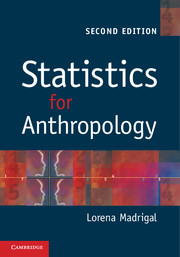Book contents
- Frontmatter
- Contents
- List of partial statistical tables
- Preface
- 1 Introduction to statistics and simple descriptive statistics
- 2 The first step in data analysis
- 3 Probability and statistics
- 4 Hypothesis testing and estimation
- 5 The difference between two means
- 6 The analysis of variance (ANOVA)
- 7 Non-parametric tests for the comparison of samples
- 8 The analysis of frequencies
- 9 Correlation analysis
- 10 Simple linear regression
- 11 Advanced topics in regression analysis
- References
- Index
7 - Non-parametric tests for the comparison of samples
Published online by Cambridge University Press: 05 June 2012
- Frontmatter
- Contents
- List of partial statistical tables
- Preface
- 1 Introduction to statistics and simple descriptive statistics
- 2 The first step in data analysis
- 3 Probability and statistics
- 4 Hypothesis testing and estimation
- 5 The difference between two means
- 6 The analysis of variance (ANOVA)
- 7 Non-parametric tests for the comparison of samples
- 8 The analysis of frequencies
- 9 Correlation analysis
- 10 Simple linear regression
- 11 Advanced topics in regression analysis
- References
- Index
Summary
Testing the assumptions of parametric tests should be a life-long practice. An analyst has two broad options if parametric test assumptions are not met: (1) The data can be transformed so that they have a normal distribution and may be analyzed with parametric tests. Transformations will be discussed in the chapter on simple linear regression since transformations are more frequently performed when doing a regression analysis. (2) The data may be analyzed with non-parametric tests which allow the researcher to answer the original question with a test that does not have the assumptions of a parametric test.
Non-parametric tests are so called because they make no reference to the parameters of the population from which the sample was obtained. Indeed, we are going to start phrasing our null hypotheses with words instead of parametric notation. These tests are also called distribution-free tests because we make no assumptions about the shape of the distribution of the population from which our sample was taken. Non-parametric tests can also be used when our sample sizes are small (say under 20), at which point we may not even want to test for normality in a sample. Anthropologists are frequently forced to work with exceedingly small samples because of the nature of our data (number of fossils, or number of non-human primate childbirths observed in the wild, etc.) so these tests have a broad appeal in the field. Lastly, non-parametric tests can be used with data that are not precisely measured. For example, if you are taking a survey on the number of domestic animals living in each household you may want to have categories such as 0, 1–2, 3–4…9–10, more than 10. The latter category is not precise since it contains everything from 11 to who-knows-what. However, non-parametric tests allow us to incorporate these types of data into a statistical analysis permitting us to test hypotheses about the sample.
- Type
- Chapter
- Information
- Statistics for Anthropology , pp. 146 - 165Publisher: Cambridge University PressPrint publication year: 2012



